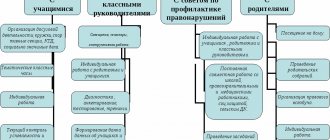A person is, first of all, a social being: he cannot build his life without interacting with other members of society, therefore, he is subject to generally accepted rules and norms established in a certain social group. Following the behavioral norms characteristic of the society in which a person lives is the basis of his socialization.
The skills necessary for active and full interaction with society are not innate: a person acquires them in the process of development. In some situations, a person consciously or unconsciously refuses to comply with established rules: in this case, psychologists talk about deviance or delinquency of his behavior. Both delinquent and deviant behavior are considered deviations from behavioral norms.
Definition of deviant and delinquent behavior
Psychologists distinguish two types of non-standard social actions: deviance and delinquency. People who are far from psychology often consider these concepts to be identical, which is not entirely true.
Deviant behavior is a relative concept, implying non-compliance with certain social norms. This concept is considered relative for the reason that certain actions can have an ambiguous interpretation in different social groups: what is considered normal for some people is a disgusting and inadequate act for others.
Informal rules in this case include:
- national traditions and local customs;
- good manners and etiquette;
- norms of behavior in any closed society.
The term "delinquent behavior" comes from the Latin noun delictum, used to mean "misdemeanor." Typically, this term refers to antisocial and illegal behavior that violates public order and threatens the rights and freedoms of other citizens. This concept is used not only by psychologists, but also by criminologists, lawyers, sociologists, and teachers.
Adolescent delinquency
In adolescents, this type of behavior usually occurs under the influence of more experienced friends who have bad habits. The friend himself is not necessarily a deviant or antisocial person. A group of teenagers who are not interested in serious activities such as sports, art or science are left to their own devices. Out of boredom, they begin to look for entertainment that can give a jolt, or even tickle their nerves. Many find an outlet in alcohol and then in drugs, which is already illegal behavior.
Excess hormones often pushes us to rash actions - conflicts that end in fights, theft from supermarkets in order to “show off our prowess,” bullying of peers or animals. Much depends on temperament: aggressiveness, adventurism, choleric personality type - fertile ground for the emergence of delinquency. Based on their characteristics, such adolescents can be divided into three groups:
- Adolescents with primitive asocial needs and a set of moral standards. Under the pressure of strong needs, internal conflict is resolved by committing an illegal act, which reduces the level of morality. However, this becomes a cause of remorse.
- Teenagers devoid of internal conflict and remorse, who do not repent of committing deviant acts. They do not have an internal moral core and follow their asocial needs, which for the most part conflict with the norms of public morality. In most cases they operate in a centralized group.
- Teenagers who deliberately violate public order. Cynical views on life, combined with strongly expressed needs, make it easy to cross the boundaries of what is permitted by committing a crime.
This does not mean at all that all teenagers without exception are like this. An example is any “positive” teenager who does not skip school, does homework, is socially active and is passionate about some hobby.
Criminologists believe that socio-economic factors significantly influence the delinquency of adolescents. Young people are highly susceptible to the influence of any factors and information: they absorb everything new like a sponge. With the correct presentation of the facts, when any crime is justified, a teenager can easily be persuaded to deviant behavior, since critical thinking is still poorly developed. This is an additional reason for parents to control the interests of the teenager and nip any type of delinquency in the bud. Despite the influence of teachers at school, the family is the main guiding and nurturing force.
On the other hand, family relationships can also cause delinquency. Inappropriate bad attitude on the part of parents is a guarantee that the teenager will look for other authorities who will not always teach good things. Often a quarrel in the family is the reason for leaving home, skipping school, fighting or hooliganism . The most serious offenses are caused not by the influence of the streets, but by relationships with members of one’s own family. It is worth noting that the reasons may lie not in open conflict, but also in a cold, distant attitude on the part of parents.
Often the origins of delinquency lie in the teenager’s rejection either at home or at school. Although the child may not show this in any way, the opinion of teachers, especially the class teacher, is very important to him. Often this is the second most important authority in the eyes of a teenager. The attitude of the director of extracurricular activities, for example, a coach in a sports section, is also important. In the absence of “feedback” , approval and support from teachers and parents, the teenager withdraws into himself. Over time, sadness gives way to aggression, and this is one of the reasons for committing various types of offenses.
Similarities and differences between the terms “deviance” and “delinquency”
Common features of deviance and delinquency:
- both terms imply deviation from generally accepted social norms. At the same time, people’s actions are compared both with legally established state norms and with informal behavioral guidelines;
- Both deviation and delinquency imply a person’s lack of desire to find his place in society, meet its requirements and comply with generally accepted rules.
If we talk about the differences between these terms, they are as follows:
- Delinquent behavior is human behavior that includes completely illegal actions. Vivid examples of delinquent behavior can be robbery, murder, any violent acts, fraud, and bullying. Delinquency includes primarily those deviations that carry legal consequences;
- Deviance is a broader concept that includes generally accepted deviations from socially approved norms.
In a narrow sense, deviant behavior may include offenses that do not entail criminal liability, and delinquent behavior may include administrative fines and criminal punishment.
Definition of the concept
Delinquency is a variant of deviant behavior. This phenomenon is interesting because there are no clear criteria by which it could be recognized. This social phenomenon is studied by various sciences:
- Pedagogy. In pedagogy, delinquent behavior is understood as the totality of an individual’s actions. The key point is that such behavior disrupts the normal functioning of the classroom or school community and threatens the safety of children or employees of the educational institution.
- Psychology. In psychology, delinquent behavior is such human actions that contradict legal, moral and ethical standards. The basis of such actions is the conflict of interests of an individual and the requirements of society, the state or a small social group. Psychologists are developing methods for diagnosing deviations and methods for correcting deviations.
- Social science and sociology. In these sciences, delinquent behavior is actions of an antisocial nature. Sociologists analyze the reasons for its occurrence and correlate them with certain historical features of the development of society.
- Law and criminology. From the point of view of jurisprudence, delinquent behavior is considered to be misdeeds, offenses, and socially dangerous acts of a minor citizen. Sanctions for them are contained in regulatory documents. This indicates that delinquent behavior is a form of criminal behavior. In other words, lawyers consider delinquency as a type of criminal action.
A delinquent is a person with delinquent behavior, and his antisocial actions are torts. A teenager who is prone to breaking laws, upon reaching 18 years of age, is considered a criminal.
As a result of a comprehensive study of the phenomenon of delinquent behavior in adolescents, its distinctive features were identified:
- the basis for the formation of such a model of life is the conflict between the individual aspirations of the individual and the interests of society;
- unlawful actions of an individual violate the usual way of social life and receive condemnation from society;
- such behavior violates the provisions of current legislation;
- it is difficult to establish the degree of responsibility of a delinquent, since there are no unambiguous criteria for classifying this form of deviation;
- organizations that combat delinquent behavior are correctional colonies for juvenile offenders, KDN and PDN.
Causes of delinquent behavior
Speaking about the prerequisites for deviation from behavioral norms, it is impossible to single out any single reason as a result of which a person’s behavior suddenly becomes asocial. Usually, there are many prerequisites for such behavior, which include both the psycho-emotional state of a person and the external factors affecting him.
Psychophysiological factors in the occurrence of delinquent behavior include personality type and character, the presence of various addictions (alcohol, drugs, gaming and others), mental illness, and level of anxiety.
If we talk about external factors influencing the human psyche, then we can highlight the family reasons for the progression of delinquency and the socio-economic prerequisites for the occurrence of such a condition.
Family factors include:
- parental divorce;
- death of a close relative with whom the person had a particularly warm relationship;
- alcoholism or drug addiction in one of the family members;
- unfavorable environment in the house: constant quarrels, swearing and fights;
- excessive guardianship on the part of parents, the desire to control every step of the child;
- physical and moral violence in the family.
Social factors include:
- social and material inequality between people;
- conflicts based on national intolerance;
- loss of work, lack of livelihood;
- change of social environment.
Types of delinquent behavior
Addiction . By this term, psychologists primarily mean harmful addictions. These include alcoholism, drug addiction, various forms of sexual and food addiction, and gambling addiction. One of the forms of addiction is a person’s belonging to a sect. In cases of addiction, there is a voluntary distancing of a person from society, a desire to live in a world of distorted reality.
Disciplinary violations . Disciplinary offenses include deliberate violation of the approved routine, failure to fulfill work and social duties, systematic tardiness, and disregard for safety precautions.
Administrative offenses . This category includes violations of public order that entail administrative liability. These include drinking alcohol in public places, using obscene language, and violating traffic rules.
Crimes .
All acts for which penalties are provided for by the Criminal Code of the state in which the person is located fall under the category of crimes. A crime is considered to be a particularly serious offense that entails serious consequences.
Features of delinquent behavior in adolescents
The concept of delinquent behavior is especially often considered in the context of studying behavioral disorders in children and adolescents. Nowadays, this problem does not lose its relevance, as psychologists and law enforcement officials note an increase in the number of serious crimes committed by minors.
Features of delinquent behavior in adolescents:
- often illegal actions are committed by a group of teenagers, since participation in some community gives a feeling of anonymity and impunity;
- delinquent behavior often begins with a denial of adult authority;
- at a young age a person shows the strongest tendency to addiction;
- The commission of offenses is facilitated by the mental instability of young people, excessive excitability and the desire to take risks.
Various forms of delinquent behavior in adolescents can be caused by selfish and violent motives. Selfish actions are committed by a teenager to obtain momentary benefits, and often the young person himself cannot explain the motives for his actions. Violent actions give a teenager an imaginary opportunity to assert himself, stand out in any social group, and emphasize his importance.
Prevention
You definitely need to be aware of who your child is communicating with.
Preventive measures must come from within the family. Parents are obliged to create a favorable emotional climate and give the child an understanding that he is needed and important. At the same time, the teenager must understand that he does not have the right to behave as he pleases towards other people, causing them harm.
During periods of crisis, a teenager needs to be explained what is good and what is bad. Parents should respond to their children’s requests, be aware of their lives, affairs and hobbies, but at the same time not try to strictly control them. The latter can cause rejection in the child and a desire to do exactly the opposite.
Parents are required to monitor the company in which their child communicates. If he has fallen under the influence of bad guys, you need to gently but firmly discourage him from this, occupying his free time with other useful and interesting things for a teenager.
Educational work should be carried out at the level of educational institutions. It is important for the latter to improve legal culture and literacy among the younger generation.
Examples of delinquent behavior
The most striking examples of delinquent behavior:
- animal abuse;
- domestic violence;
- prostitution;
- vandalism;
- deliberate destabilization of the situation in society in times of crisis;
- creating fake news;
- alcoholism, drug addiction and their consequences;
- begging;
- participation in terrorist groups;
- creation and distribution of pornographic materials;
- inclination to suicidal actions;
- other administrative and criminal offenses.
One of the most important causes of delinquency is a person’s distorted moral consciousness. The tendency to such manifestations is formed at a very young age, so prevention of behavioral deviations must be carried out from the early years of a child’s life.
Regulation and correction of the behavior of people prone to delinquency occurs through the establishment of legislative norms. People who do not comply with traditional behavioral norms are subject to social condemnation, which can also be effective in the early stages of delinquency.
Portrait of a person with delinquent behavior, examples from literature
A person with this type of behavior can be either a man or a woman. His main difference from the others is his isolation, a certain gloominess is possible. It often happens that the criminal is outwardly beautiful, which endears him to people. He is smart, suspicious, and may have childhood traumas.
Often in classical literature you can find heroes with delinquency, which is reflected in their actions. Thus, in his work “Lady Macbeth of Mtsensk,” Leskov tells the story of Catherine, who kills her father-in-law, husband, nephew, and a girl attracted by her lover. She also commits suicide at the end. This is a clear example of actions that deviate from the norm. It’s no secret that Rodion Raskolnikov from the novel “Crime and Punishment” is another representative of delinquent behavior: he kills an old money-lender and steals jewelry from her.











